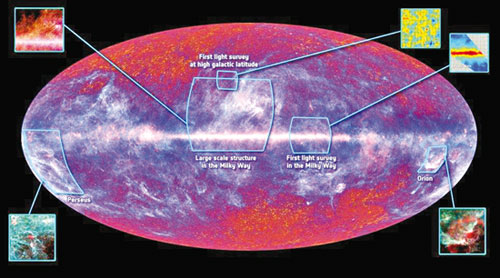Oldest light shows images from Big Bang
The big bang theory is famous throughout the world as the way of
explaining how the universe came to life. The framework for the model
relies on Albert Einstein's general relativity and on simplifying
assumptions. What existed prior to this event is completely unknown and
is a matter of pure speculation. This occurrence was not a conventional
explosion but rather an event filling all of space with all of the
particles of the embryonic universe rushing away from each other. The
Big Bang actually consisted of an explosion of space within itself
unlike an explosion of a bomb were fragments are thrown outward.
|

The oldest light in the Universe; The familiar constellation
Orion can be seen in the far-right corner. Picture ESA |
The galaxies were not all clumped together, but rather the Big Bang
laid the foundations for the universe. After its initial appearance, it
apparently inflated, expanded and cooled, going from very, very small
and very, very hot, to the size and temperature of our current universe.
It continues to expand and cool to this day.
The origin of the Big Bang theory can be credited to Edwin Hubble.
Hubble made the observation that the universe is continuously expanding.
The theory is supported by the most comprehensive and accurate
explanations from current scientific evidence and observation. According
to the best available measurements as of 2010, the initial conditions
occurred around 13.3 to 13.9 billion years ago.
This incredible image shows the remains of the fireball out of which
our Universe sprang into existence 13.7 billion years ago and, this is
the oldest light in the Universe.
It provides scientists with new insight into the way stars and
galaxies form. It also tells us how the Universe itself came to life
after the Big Bang. It was produced by a European space telescope called
'Planck' and is the mission's first 'all-sky' image, which took six
months to create.
While the Milky Way shows us what the local Universe looks like now,
the microwaves in the background of this image show us what the Universe
probably looked like close to its time of creation, before there were
stars or galaxies.
'This is the moment that Planck was conceived for,' says ESA Director
of Science and Robotic Exploration, David Southwood. 'We're not giving
the answer. We are opening the door to opportunities where scientists
can seek the nuggets that will lead to deeper understanding of how our
Universe came to be and how it works now.
The image itself and its remarkable quality is a tribute to the
engineers who built and have operated Planck. Now the scientific harvest
must begin...' From the closest portions of the Milky Way to the
furthest reaches of space and time, the new all-sky Planck image is an
extraordinary treasure chest of new data for astronomers. This galactic
web is where new stars are being formed and Planck has found many
locations where individual stars are edging toward birth or just
beginning their cycle of development.
The most interesting is the mottled backdrop at the top and bottom.
This is the 'cosmic microwave background radiation'.
The microwave pattern is the cosmic blueprint from which today's
clusters and super clusters of galaxies were built.
The different colours represent minute differences in the temperature
and density of matter across the sky. Somehow these small irregularities
evolved into denser regions that became the galaxies of today.
The Cosmic microwave background radiation covers the entire sky. When
this work is completed, Planck will show us the most precise picture of
the microwave background ever obtained. This era is believed to have
taken place just after the Big Bang and resulted in the Universe
expanding enormously in size over an extremely short period. Planck
continues to map the Universe. By the end of its mission in 2012, it
will have completed four all-sky scans.
- Chamari Senanayake |



